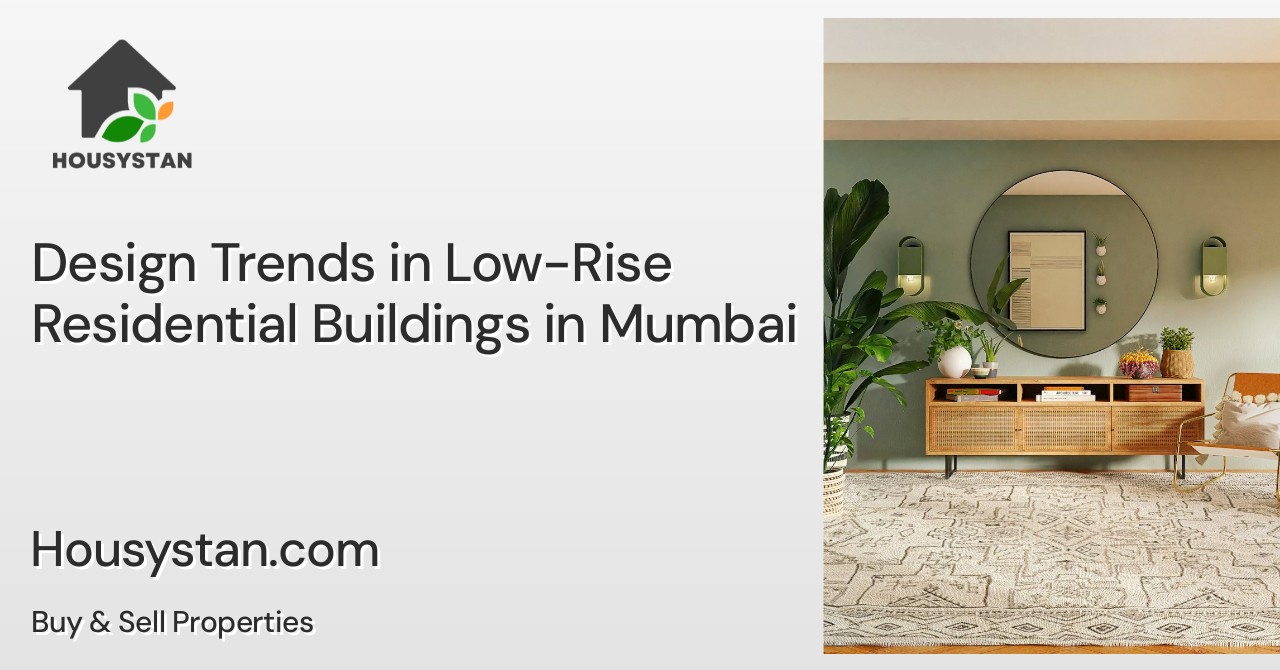Design Trends in Low-Rise Residential Buildings in Mumbai
Read latest blogs and articles from Housystan

The Information mentioned here was last updated on:
21/12/2025Exploring Design Trends in Low-Rise Residential Buildings in Mumbai
Mumbai, a bustling metropolis on India’s west coast, is renowned for its towering skyscrapers and densely packed urban landscapes. However, an often understated but equally intriguing architectural phenomenon is the emergence of low-rise residential buildings. These structures, typically not exceeding four floors, are becoming increasingly popular as they blend seamlessly with the city’s rich cultural tapestry. Let's dive into some of the prevailing design trends for these low-rise residences and understand their growing appeal.
Reviving Traditional Architecture
- Verified Tenants/Buyers
- Unlimited Property Listing
- Zero subscription/charges fee
Incorporating Local Design Elements
Mumbai’s low-rise residential buildings frequently draw inspiration from traditional architectural styles. Intricate window grills, ornate balconies, and locally sourced materials like stone and wood echo the city's historical structures. These elements not only enhance aesthetic appeal but also honor Mumbai's cultural heritage. Architects often integrate locally-inspired patterns and motifs, creating a visual link to the city’s storied past.
Focus on Sustainable Building Practices
Environmental awareness is a growing global concern, and Mumbai is no exception. Low-rise residential buildings are increasingly designed with sustainability in mind. Many architects opt for eco-friendly building materials, such as fly ash bricks, and implement energy-efficient systems. Solar panels and rainwater harvesting are common additions, which help reduce the carbon footprint and promote sustainability, making these homes appealing to environmentally-conscious buyers.
Emphasizing Community and Connectivity
Open and Adaptive Spaces
A major trend in Mumbai's low-rise buildings is the emphasis on community and open spaces. Whereas urban high-rise apartments can feel isolated, low-rise structures offer communal areas like courtyards and terraces. These spaces foster a sense of community among residents, providing areas for social gatherings, leisure activities, and even urban farming. Such spaces adapt to the residents' needs, offering flexibility in their use.
Integration of Green Spaces
With the shortage of open spaces in metropolitan areas, integrating greenery within residential complexes has gained immense popularity. Low-rise buildings are particularly suited for this, as they can easily incorporate gardens, vertical planters, and rooftop vegetation. These green areas not only beautify the surroundings but also improve air quality and provide residents with a serene escape from the urban hustle.
Blending Modern and Minimalistic Designs
Use of Natural Lighting and Ventilation
Natural lighting and ventilation are key features in modern low-rise buildings. Architects prioritize large windows, skylights, and clever floor plans to maximize the inflow of sunlight and fresh air. This not only enhances the living experience but also reduces reliance on artificial lighting and air conditioning, decreasing energy consumption.
Minimalist Interior Design
The minimalist design trend, characterized by clean lines and uncluttered spaces, is making its way into Mumbai’s low-rise residences. This style emphasizes functionality and simplicity, focusing on quality materials and harmonious color schemes. Interiors often feature open floor plans with multifunctional spaces, allowing residents to customize their homes according to their needs and preferences.
Exploring Technological Innovations
Smart Home Features
The rise of smart home technology is influencing the design of low-rise buildings. From automated lighting and temperature controls to security systems that provide real-time updates, such innovations offer enhanced convenience and safety. Many new constructions incorporate these technologies, making them more attractive to tech-savvy homebuyers.
Leveraging Modular Designs
Modular construction is gaining traction as a means of addressing the challenges of urban housing. Prefabricated units are assembled off-site and then transported to the building location, significantly reducing construction time and cost. This method allows for versatile designs and customization, catering to diverse aesthetic and functional needs.
Preserving Privacy in Densely Populated Areas
Thoughtful Layout Designs
Despite occupying a smaller footprint, low-rise buildings strategically maintain privacy for residents. By carefully considering sightlines, window placements, and spatial arrangements, architects mitigate concerns of overlooking and intrusion. This attention to detail ensures that even in densely populated neighborhoods, occupants can enjoy their personal space.
Acoustic Design Considerations
Noise pollution is an unavoidable reality in a vibrant city like Mumbai. Thus, acoustic design becomes pivotal in creating a peaceful living environment. Low-rise residences incorporate soundproofing techniques such as double-glazed windows and insulated walls to minimize outside noise, enhancing the quality of life for inhabitants.
Adapting to Changing Lifestyle Preferences
Need for Flexibility
Today’s residential spaces need to accommodate shifting lifestyle dynamics. Whether it’s remote working, fitness regimens, or entertainment needs, low-rise homes are designed with adaptable spaces that support various activities. Multi-use rooms that can function as workspaces, gyms, or media rooms allow residents to adjust them as per their daily needs.
Catering to Different Demographics
The design of low-rise residences reflects Mumbai›s diverse population. These buildings often include varied unit types and sizes, from compact studios for young professionals to spacious apartments for families. This versatility ensures that low-rise buildings appeal to a broad audience, addressing the housing needs of different demographic groups.
Conclusion
In summary, low-rise residential buildings in Mumbai are evolving with design trends that prioritize sustainability, community-focused living, and modern conveniences. These structures provide a refreshing contrast to the city’s towering high-rises, offering a more intimate living experience without sacrificing urban conveniences. By embracing traditional architectural elements, promoting green spaces, and integrating technological advancements, Mumbai’s low-rise residences are not only enriching the cityscape but are also redefining urban living for their inhabitants.